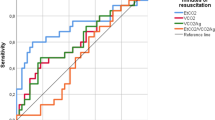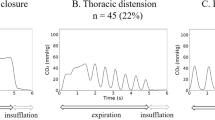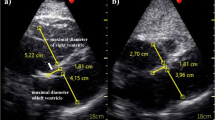Abstract
We aimed to evaluate a volumetric capnography (Vcap)-derived parameter, the volume of CO2 eliminated per minute and per kg body weight (VCO2/kg), as an indicator of the quality of chest compression (CC) and to predict the return to spontaneous circulation (ROSC) under stable ventilation status. Twelve male domestic pigs were utilized for the randomized crossover study. After 4 min of untreated ventricular fibrillation (VF), mechanical cardiopulmonary resuscitation and ventilation were administered. Following 5-min washout periods, each animal underwent two sessions of experiments: three types of CC quality for 5 min stages in the first session, followed by advanced life support, consecutively in two sessions. Different CC quality had a significant effect on the partial pressure of end-tidal carbon dioxide (PetCO2), VCO2/kg, aortic pressure (mean), aortic systolic pressure, aortic diastolic pressure, right atrial pressure (mean), and carotid blood flow (P < 0.05). With the improvement in CC quality, the values of PetCO2 and VCO2/kg also increased, and the difference between the groups was statistically significant (P < 0.05). The Spearman rank test revealed a significant correlation between the Vcap-derived parameters and hemodynamics. PetCO2 and VCO2/kg have similar capabilities for discriminating survivors from non-survivors, and the area under the curve for both was 0.97. VCO2/kg had similar performance as PetCO2 in reflecting the quality of CC and prediction of achieving ROSC under stable ventilation status in a porcine model of VF-related cardiac arrest. However, VCO2/kg requires a longer time to achieve a stable state after adjusting for quality of CC than PetCO2.



Similar content being viewed by others
Availability of data and materials
Supplementary data associated with this article can be found online at https://doi.org/10.17632/7p27nk75k3.4.
References
Meaney PA, Bobrow BJ, Mancini ME, Christenson J, de Caen AR, Bhanji F, Abella BS, Kleinman ME, Edelson DP, Berg RA, Aufderheide TP, Menon V, Leary M, CPR Quality Summit Investigators, the American Heart Association Emergency Cardiovascular Care Committee, and the Council on Cardiopulmonary, Critical Care, Perioperative and Resuscitation. Cardiopulmonary resuscitation quality: improving cardiac resuscitation outcomes both inside and outside the hospital: a consensus statement from the American Heart Association. Circulation. 2013;128:417–35. https://doi.org/10.1161/cir.0b013e31829d8654.
Ryan AM, Bentley JB, Daniel WS, Hu C, McDannold R, Vadeboncoeur TF. Association between prehospital CPR quality and end-tidal carbon dioxide levels in out-of-hospital cardiac arrest. Prehosp Emerg Care. 2016;20:369–77. https://doi.org/10.3109/10903127.2015.1115929.
Callaway CW, Soar J, Aibiki M, Böttiger BW, Brooks SC, Deakin CD, Donnino MW, Drajer S, Kloeck W, Morley PT, Morrison LJ, Neumar RW, Nicholson TC, Nolan JP, Okada K, O’Neil BJ, Paiva EF, Parr MJ, Wang TL, Witt J, Collaborators ALSC. Part 4: advanced life support: 2015 international consensus on cardiopulmonary resuscitation and emergency cardiovascular care science with treatment recommendations. Circulation. 2015;132:S84–145. https://doi.org/10.1161/cir.0000000000000273.
de Caen AR, Maconochie IK, Aickin R, Atkins DL, Biarent D, Guerguerian AM, Kleinman ME, Kloeck DA, Meaney PA, Nadkarni VM, Ng KC, Nuthall G, Reis AG, Shimizu N, Tibballs J, Veliz Pintos R, Support PBL, Collaborators PALSC. Part 6: pediatric basic life support and pediatric advanced life support: 2015 international consensus on cardiopulmonary resuscitation and emergency cardiovascular care science with treatment recommendations. Circulation. 2015;132:S177–203. https://doi.org/10.1161/cir.0000000000000275.
Meaney PA, Bobrow BJ, Mancini ME, Christenson J, de Caen AR, Bhanji F, Abella BS, Kleinman ME, Edelson DP, Berg RA, Aufderheide TP, Menon V, Leary M, CPR Quality Summit Investigators, the American Heart Association Emergency Cardiovascular Care Committee, and the Council on Cardiopulmonary, Critical Care, Perioperative and Resuscitation. Cardiopulmonary resuscitation quality: [corrected] improving cardiac resuscitation outcomes both inside and outside the hospital: a consensus statement from the American Heart Association. Circulation. 2013;128:417–35. https://doi.org/10.1161/cir.0b013e31829d8654.
Morgan RW, Kilbaugh TJ, Shoap W, Bratinov G, Lin Y, Hsieh TC, Nadkarni VM, Berg RA, Sutton RM, Investigators PCASOPL. A hemodynamic-directed approach to pediatric cardiopulmonary resuscitation (HD-CPR) improves survival. Resuscitation. 2017;111:41–7. https://doi.org/10.1016/j.resuscitation.2016.11.018.
Berg RA, Sutton RM, Reeder RW, Berger JT, Newth CJ, Carcillo JA, McQuillen PS, Meert KL, Yates AR, Harrison RE, Moler FW, Pollack MM, Carpenter TC, Wessel DL, Jenkins TL, Notterman DA, Holubkov R, Tamburro RF, Dean JM, Nadkarni VM, Eunice Kennedy Shriver National Institute of Child Health and Human Development Collaborative Pediatric Critical Care Research Network (CPCCRN) PICqCPR (Pediatric Intensive Care Quality of Cardio-Pulmonary Resuscitation) Investigators. Association between diastolic blood pressure during pediatric in-hospital cardiopulmonary resuscitation and survival. Circulation. 2018;137:1784–95. https://doi.org/10.1161/circulationaha.117.032270.
Sutton RM, Friess SH, Bhalala U, Maltese MR, Naim MY, Bratinov G, Niles D, Nadkarni VM, Becker LB, Berg RA. Hemodynamic directed CPR improves short-term survival from asphyxia-associated cardiac arrest. Resuscitation. 2013;84:696–701. https://doi.org/10.1016/j.resuscitation.2012.10.023.
Sutton RM, Friess SH, Maltese MR, Naim MY, Bratinov G, Weiland TR, Garuccio M, Bhalala U, Nadkarni VM, Becker LB, Berg RA. Hemodynamic-directed cardiopulmonary resuscitation during in-hospital cardiac arrest. Resuscitation. 2014;85:983–6. https://doi.org/10.1016/j.resuscitation.2014.04.015.
Neumar RW, Otto CW, Link MS, Kronick SL, Shuster M, Callaway CW, Kudenchuk PJ, Ornato JP, McNally B, Silvers SM, Passman RS, White RD, Hess EP, Tang W, Davis D, Sinz E, Morrison LJ. Part 8: adult advanced cardiovascular life support: 2010 American Heart Association Guidelines for Cardiopulmonary Resuscitation and Emergency Cardiovascular Care. Circulation. 2010;122:S729–67. https://doi.org/10.1161/circulationaha.110.970988.
Pantazopoulos C, Xanthos T, Pantazopoulos I, Papalois A, Kouskouni E, Iacovidou N. A review of carbon dioxide monitoring during adult cardiopulmonary resuscitation. Heart Lung Circ. 2015;24:1053–61. https://doi.org/10.1016/j.hlc.2015.05.013.
Kodali BS, Urman RD. Capnography during cardiopulmonary resuscitation: current evidence and future directions. J Emerg Trauma Shock. 2014;7:332–40. https://doi.org/10.4103/0974-2700.142778.
Soar J, Nolan JP, Böttiger BW, Perkins GD, Lott C, Carli P, Pellis T, Sandroni C, Skrifvars MB, Smith GB, Sunde K, Deakin CD, Adult advanced life support section Collaborators. European resuscitation council guidelines for resuscitation 2015: section 3. Adult advanced life support. Resuscitation. 2015;95:100–47. https://doi.org/10.1016/j.resuscitation.2015.07.016.
Murphy RA, Bobrow BJ, Spaite DW, Hu C, McDannold R, Vadeboncoeur TF. Association between prehospital CPR quality and end-tidal carbon dioxide levels in out-of-hospital cardiac arrest. Prehosp Emerg Care. 2016;20:369–77. https://doi.org/10.3109/10903127.2015.1115929.
Aufderheide TP, Lurie KG. Death by hyperventilation: a common and life-threatening problem during cardiopulmonary resuscitation. Crit Care Med. 2004;32:S345–51. https://doi.org/10.1097/01.ccm.0000134335.46859.09.
Park SO, Shin DH, Baek KJ, Hong DY, Kim EJ, Kim SC, Lee KR, TraumaRegister DGU. A clinical observational study analysing the factors associated with hyperventilation during actual cardiopulmonary resuscitation in the emergency department. Resuscitation. 2013;84:298–303. https://doi.org/10.1016/j.resuscitation.2012.07.028.
Gazmuri RJ, Ayoub IM, Radhakrishnan J, Motl J, Upadhyaya MP. Clinically plausible hyperventilation does not exert adverse hemodynamic effects during CPR but markedly reduces end-tidal PCO2. Resuscitation. 2012;83:259–64. https://doi.org/10.1016/j.resuscitation.2011.07.034.
Alexandra MM, Ryan WM, Catherine ER, Berg RA, Sutton RM. Physiology-directed cardiopulmonary resuscitation: advances in precision monitoring during cardiac arrest. Curr Opin Crit Care. 2018;24:143–50. https://doi.org/10.1097/mcc.0000000000000499.
Xu J, Yu X, Zhang L, Fu Y, Jin K, Yin L, Yu S, Liu D. Modified volumetric capnography-derived parameter: a potentially stable indicator in monitoring cardiopulmonary resuscitation efficacy in a porcine model. Resuscitation. 2020;150:94–101. https://doi.org/10.1016/j.resuscitation.2020.02.039.
Falk JL, Rackow EC, Weil MH. End-tidal carbon dioxide concentration during cardiopulmonary resuscitation. N Engl J Med. 1988;318:607–11. https://doi.org/10.1056/nejm198803103181005.
Segal N, Metzger AK, Moore JC, India L, Lick MC, Berger PS, Tang W, Benditt DG, Lurie KG. Correlation of end tidal carbon dioxide, amplitude spectrum area, and coronary perfusion pressure in a porcine model of cardiac arrest. Physiol Rep. 2017;5:e13401. https://doi.org/10.14814/phy2.13401.
Skulec R, Vojtisek P, Cerny V. Correlation between end-tidal carbon dioxide and the degree of compression of heart cavities measured by transthoracic echocardiography during cardiopulmonary resuscitation for out-of-hospital cardiac arrest. Crit Care. 2019;23:334. https://doi.org/10.1186/s13054-019-2607-2.
Anderson CT, Breen PH. Carbon dioxide kinetics and capnography during critical care. Crit Care. 2000;4:207–15. https://doi.org/10.1186/cc696.
Hwang K, Chon S-B, Im JG. The optimum chest compression site with regard to heart failure demonstrated by computed tomography. Am J Emerg Med. 2017;35:1899–906. https://doi.org/10.1016/j.ajem.2017.07.041.
Segal N, Robinson AE, Berger PS, Lick MC, Moore JC, Salverda BJ, Hinke MB, Ashton AA, McArthur AM, Lurie KG, Metzger AK. Chest compliance is altered by static compression and decompression as revealed by changes in anteroposterior chest height during CPR using the ResQPUMP in a human cadaver model. Resuscitation. 2017;116:56–9. https://doi.org/10.1016/j.resuscitation.2017.04.032.
Ryu SJ, Lee SJ, Park CH, Lee SM, Lee DH, Cho YS, Jung YH, Lee BK, Jeung KW. Arterial pressure, end-tidal carbon dioxide, and central venous oxygen saturation in reflecting compression depth. Acta Anaesthesiol Scand. 2016;60:1012–23. https://doi.org/10.1111/aas.12728.
Ahrens T, Schallom L, Bettorf K, Ellner S, Hurt G, O’Mara V, Ludwig J, George W, Marino T, Shannon W. End-tidal carbon dioxide measurements as a prognostic indicator of outcome in cardiac arrest. Am J Crit Care. 2001;10:391–8.
Pokorna MAM, Necas E. End tidal CO2 monitoring in condition of constant ventilation: a useful guide during advanced cardiac life support. Prague Med Rep. 2006;107:317–26.
Hartmann SM, Farris RWD, Di Gennaro JL, Roberts JS. Systematic review and meta-analysis of end-tidal carbon dioxide values associated with return of spontaneous circulation during cardiopulmonary resuscitation. J Intensive Care Med. 2015;30:426–35. https://doi.org/10.1177/0885066614530839.
Paiva EF, Paxton JH, O’Neil BJ. The use of end-tidal carbon dioxide measurement to guide management of cardiac arrest: a systematic review. Resuscitation. 2018;123:1–7. https://doi.org/10.1016/j.resuscitation.2017.12.003.
Trevino RP, Bisera J, Weil MH, Rackow EC, Grundler WG. End-tidal CO2 as a guide to successful cardiopulmonary resuscitation: a preliminary report. Crit Care Med. 1985;13:910–1. https://doi.org/10.1097/00003246-198511000-00012.
Levine RLWM, Miller CC. End-tidal carbon dioxide and outcome of out-of-hospital cardiac arrest. N Engl J Med. 1997;337:301–6.
Callaham M, Barton C. Prediction of outcome of cardiopulmonary resuscitation from end-tidal carbon dioxide concentration. Crit Care Med. 1990;18:358–62. https://doi.org/10.1097/00003246-199004000-00002.
Cantineau Merckx P, Lambert Y, Sorkine M, Bertrand C, Duvaldestin P. Effect of epinephrine on end-tidal carbon dioxide pressure during prehospital cardiopulmonary resuscitation. Am J Emerg Med. 1994;12:267–70. https://doi.org/10.1016/0735-6757(94)90136-8.
Sheak KR, Wiebe DJ, Leary M, Babaeizadeh S, Yuen TC, Zive D, Owens PC, Edelson DP, Daya MR, Idris AH, Abella BS. Quantitative relationship between end-tidal carbon dioxide and CPR quality during both in-hospital and out-of-hospital cardiac arrest. Resuscitation. 2015;89:149–54. https://doi.org/10.1016/j.resuscitation.2015.01.026.
Brinkrolf P, Borowski M, Metelmann C, Lukas RP, Pidde-Kullenberg L, Bohn A. Predicting ROSC in out-of-hospital cardiac arrest using expiratory carbon dioxide concentration: is trend-detection instead of absolute threshold values the key? Resuscitation. 2018;122:19–24. https://doi.org/10.1016/j.resuscitation.2017.11.040.
Acknowledgements
This work was supported by the Chinese Academy of Medical Sciences (CAMS) Innovation Fund for Medical Sciences (2017-I2M-1-009). The funding was used to purchase landrace cross pigs, experimental drugs, and disposable medical consumables. The sponsor was not involved in designing the study, in the collection and analysis of data, in the writing of the manuscript, or in the decision to submit the manuscript for publication.
Funding
This work was supported by the Chinese Academy of Medical Sciences Innovation Fund for Medical Sciences (2017-I2M-1-009). The funding was used to purchase landrace cross pigs, experimental drugs, and disposable medical consumables. The sponsor was not involved in designing the study, in the collection and analysis of data, in the writing of the manuscript, or in the decision to submit the manuscript for publication.
Author information
Authors and Affiliations
Contributions
Conceptualization: JX, XY, and LZ. Supervision: JX and XY. Project administration: JX, XY, and HZ. Validation: JX and XY. Funding acquisition: XY. Methodology: LZ, KJ, and FS. Writing—original draft: LZ, KJ, and FS. Writing—review & editing: JX. Investigation: LZ, KJ, and FS. Resources: YF. Visualization: YF. Formal analysis: DL and SY. Data curation: DL and SY.
Corresponding authors
Ethics declarations
Conflict of interest
All authors declare that they have no conflict of interest.
Ethical approval
All experiments were performed in accordance with the National Institutes of Health Guidelines, and under protocols approved by the Institutional Animal Care and Use Committee of the Peking union medical college.
Informed consent
Not applicable.
Research involving animal rights
This experimental animal study was approved by the Welfare and Ethical Inspection committee in Animal Experimentation of the Peking Union Medical College Hospital (Protocol Number: XHDW-2019-23).
Additional information
Publisher's Note
Springer Nature remains neutral with regard to jurisdictional claims in published maps and institutional affiliations.
Rights and permissions
About this article
Cite this article
Zhang, L., Jin, K., Sun, F. et al. Assessment of a new volumetric capnography-derived parameter to reflect compression quality and to predict return of spontaneous circulation during cardiopulmonary resuscitation in a porcine model. J Clin Monit Comput 36, 199–207 (2022). https://doi.org/10.1007/s10877-020-00637-1
Received:
Accepted:
Published:
Issue Date:
DOI: https://doi.org/10.1007/s10877-020-00637-1




